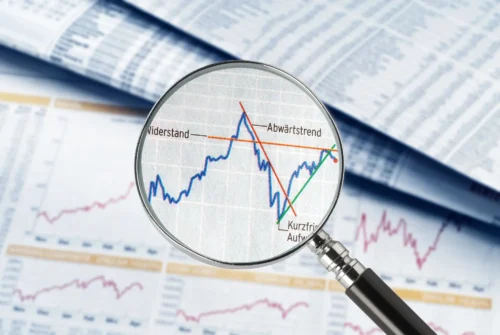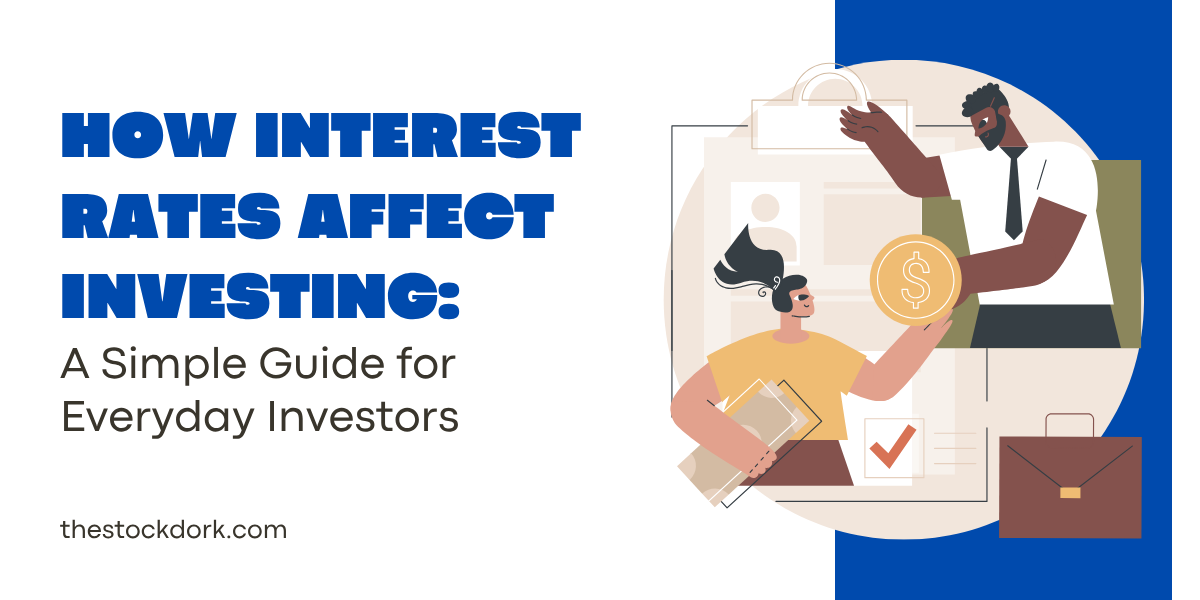Interest rates can have a profound impact on the stock market and investing, but have you ever really stopped to think about why that is? These sometimes subtle movements can lead to large stock swings that can catch us off guard if we’re not prepared.
This article looks at what interest rates are, why they can cause so much turmoil, and ways you can stay grounded even when shifts occur.
Understanding What Interest Rates Really Are
When it comes to borrowing money, interest rates are the additional percentage you pay back on the principal.
If someone asks you to loan them $100, you can charge them interest when they return the money to you as a “cost” of the transaction. Setting a rate of 5% means they’ll pay you back an extra $5, or $105 in total.
Interest rates on a larger scale aren’t quite so informal. The Federal Reserve sets what’s called the “federal funds rate,” which influences almost every other rate in the economy—mortgages, car loans, business loans, and credit cards.
Knowing these numbers before making a large purchase can help you discern what your final cost will be, and rates can change significantly depending on the season. 
How Interest Rates Affect the Stock Market
When interest rates rise, companies must pay more to borrow. Higher costs can eat into profits, often causing stock prices to fall when the Fed tightens policy. Growth-focused sectors like technology and biotech tend to drop the most because their future earnings are worth less when discounted at higher rates.
When rates fall, the opposite happens. Lower borrowing costs help companies expand. Consumers also feel freer to spend, lifting sales and profits. Suddenly, stocks look attractive again, and money flows back into the market. This back-and-forth is what creates the close relationship between interest rates and stock prices.
The Fed’s Role in Market Movements
The Federal Reserve’s main job is to keep inflation under control and employment strong. It does that by adjusting rates and sometimes buying or selling government bonds.
When inflation climbs, the Fed raises rates to cool spending. When the economy weakens, it cuts rates to make borrowing easier. As you can probably see, these fluctuations can give rise to large-scale changes in the stock market.
These changes don’t just affect Wall Street. They reach your savings account, your mortgage, and your investment portfolio, which is why following central bank policy matters even if you’re just starting out.
What Happens to Bonds When Rates Change
Bonds might seem boring compared to stocks, but they react dramatically to interest rates. Generally speaking, when interest rates go up, bond prices go down. When rates fall, bond prices go up.
Imagine you own a bond that pays a fixed 3 percent interest rate. If new bonds are suddenly paying 5 percent, yours doesn’t look so appealing anymore. The value of these lower existing bonds falls, because why would anyone pay for a 3% bond when they can get a 5% one instead?
Knowing this can help you manage your risk. The longer a bond’s maturity, the more sensitive it is to rate changes. That’s one of the core lessons about interest rates and portfolio management—matching the length of your investments to your goals helps protect you when markets shift.
How Interest Rates Affect Savings and Investments
When the Fed raises rates, savings accounts, certificates of deposit, and money market funds start paying more. That feels like a win for savers. But it also means borrowing gets pricier, which can slow business growth.
During low-rate periods, the opposite happens. Savings earn less, and investors searching for better returns often move money into stocks or real estate. This is how interest rates influence investor behavior. People shift between saving and investing based on what feels rewarding at the moment.
Simply put, when returns on cash are low, investors reach for yield. When returns on cash rise, they pull back.
How Interest Rates Shape the Economy
Interest rates aren’t just numbers on a chart—they’re signals that ripple through everything. When borrowing costs rise, companies slow expansion, hiring cools, and consumers spend less. The slower growth has its initial downsides, but it’s a strategy the Fed employs to ease inflation.
As rates fall, borrowing increases, businesses hire, and the economy strengthens again.
This cycle explains the deep effects of interest rate changes on the economy. It’s a balancing act, and the Fed constantly tries to keep it steady. For investors, understanding this rhythm helps predict which parts of the market might do well.
Financial stocks, for example, sometimes benefit from higher rates because banks earn more on loans. Real estate and technology, on the other hand, tend to thrive when borrowing is cheaper. These shifts show why the impact of interest rates on investments varies widely across sectors. 
How Interest Rates Affect Real Estate Investing
Real estate reacts quickly to interest rate changes. When mortgage rates rise, buying a home or financing a property becomes more expensive. Demand slows, and prices may level off.
When rates drop, activity picks up. People refinance, developers build, and home values often climb again. This dynamic defines how interest rates affect real estate investing. It’s a direct example of how rate policy moves real-world markets.
If you invest through a real estate investment trust, or REIT, another pattern emerges. Rising rates can make their dividends less attractive compared with bonds, while falling rates can send REIT prices higher.
The Connection Between Interest Rates, Inflation, and Returns
Inflation and interest rates always travel together. When prices rise too fast, the Fed lifts rates to slow spending. When inflation cools, it cuts rates to encourage borrowing again.
This means that interest rates and inflation shape both risks and rewards. High inflation can erode purchasing power, but high rates can create opportunities in savings accounts, Treasury bills, or new bonds with better yields. Understanding how interest rates affect returns helps investors make sense of what looks like market chaos.
Fortunately, you don’t have to predict every twist. The key is knowing that rate and inflation cycles are part of a long-term pattern. Markets recover, and patient investors benefit over time.
Investing During High Interest Rates
Periods of high interest rates often make people nervous, but they can also be moments of opportunity.
During these times, value stocks and companies with strong balance sheets often perform better than fast-growing startups that rely on cheap borrowing. Bonds issued during high-rate periods also offer higher yields, giving investors steady income.
How Do Falling Interest Rates Affect Investments?
Falling rates usually lift markets. As borrowing costs drop, companies expand, consumers spend, and investors feel optimistic again.
We sat in a period of low rates just a few years back. Stocks surged, real estate climbed, and even risky assets gained momentum. Lower rates make money cheaper, so investors are willing to take more chances in search of better returns.
While that optimism can create bubbles, it also reminds us that rate cycles come and go. Keeping a balanced portfolio means you’ll have something working for you in any environment.
How Do Interest Rates Impact Risk and Return?
Interest rates set the baseline for all investing. When they’re low, returns on safe assets shrink, so people chase higher yields in riskier places. When rates rise, the opposite happens—investors pull back toward safety.
It’s a constant trade-off. You can’t avoid risk, but you can decide how much of it makes sense for your goals.
By staying aware of this link, you can manage your exposure calmly instead of reacting emotionally to every rate announcement.
The Long View for Everyday Investors
Everything we experience in the stock market is part of a long-term cycle, and you need to be prepared for the ride. Interest rates affect everything—stocks, bonds, real estate, savings accounts, and even job markets, but you need to stay patient.
Some years markets rise fast, other years they drift sideways. But history shows that over time, disciplined investors who stay diversified through all rate environments tend to build wealth steadily.
At the end of the day, it’s not about guessing what the Fed will do next week. It’s about knowing that rate cycles are temporary, while good investment habits last.
Conclusion
Interest rates might sound technical, but their influence on investing is simply about cause and effect—money becomes cheaper or more expensive, and markets adjust.
There will always be anxious moments when rates rise and prices fall, but those same periods also create opportunities. High rates reward savers, new bonds offer better yields, and strong companies prove their worth.
Learning how interest rates affect investing is like learning how tides affect the ocean. Once you know the ebb and flow, you can move with them instead of against them. Stay curious, stay balanced, and remember that every rate change is just another chapter in a much longer story—the one where patience and knowledge build real financial confidence.


 Tags:
Tags:










